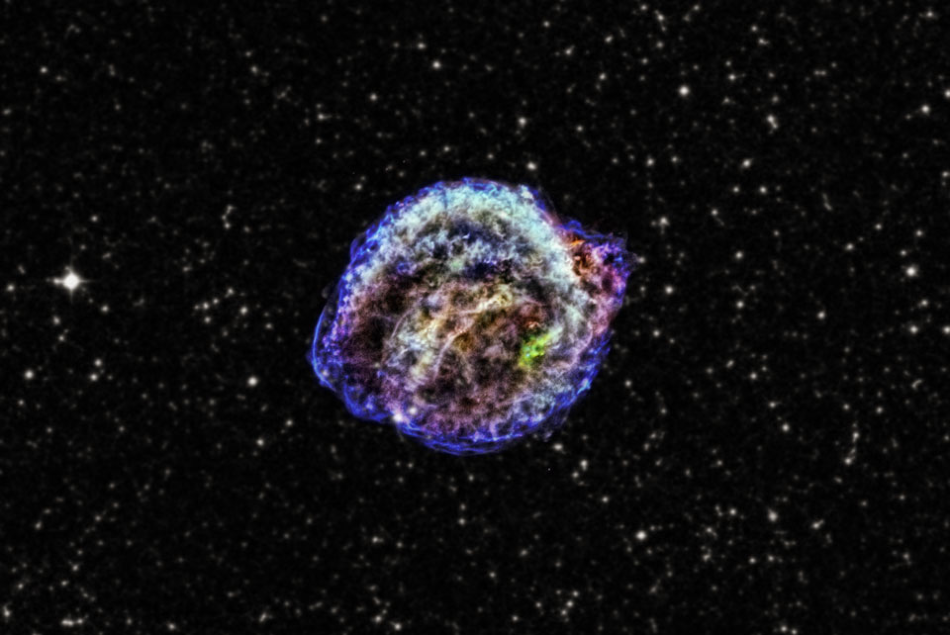Jan 13 2020
A research team, including several scientists from the Technical University of Darmstadt (TU Darmstadt) and GSI Helmholtzzentrum für Schwerionenforschung (GSI), has experimentally established the properties of nuclear processes in matter that is 25 times hotter and 10 million times denser than the core of the Sun.
 Kepler’s supernova remnant. Image Credit: GSI Helmholtzzentrum für Schwerionenforschung.
Kepler’s supernova remnant. Image Credit: GSI Helmholtzzentrum für Schwerionenforschung.
The measurement result is that intermediate-mass stars can potentially explode and not collapse as believed until now. The study results have been published in Physical Review Letters—a scientific magazine.
These findings emphasize the interesting opportunities provided by upcoming accelerator facilities such as the Facility for Antiproton and Ion Research (FAIR) in interpreting the processes that define the emergence of the Universe.
Stars are known to exhibit different evolutionary paths based on their mass. The Sun and other low-mass stars will ultimately turn out to be white dwarfs. By contrast, giant stars finish with a tremendous explosion called a supernova and leave behind a black hole or a neutron star.
While the outcome of both high-mass stars and low-mass stars is known well, the situation with respect to intermediate-mass stars, weighing between 7 and 11 times equivalent to the Sun, has continued to be a mystery. This is quite amazing because intermediate-mass stars are still existing in the Milky Way galaxy.
The final fate of intermediate-mass stars depends on a tiny detail, namely, how readily the isotope neon-20 captures electrons in the stellar core. Depending on this electron capture rate, the star will be either disrupted in a thermonuclear explosion or it will collapse to form a neutron star.
Professor Gabriel Martínez-Pinedo, Research Department Theory, GSI Helmholtzzentrum für Schwerionenforschung and the Institut für Kernphysik
According to Karlheinz Langanke, a Professor and Research Director of GSI and FAIR, “This work started when we realized that a strongly suppressed, and hence previously ignored and experimentally unknown, transition between the ground states of neon-20 and fluorine-20 was a key piece of information needed to determine the electron capture rate in intermediat- mass stars.”
Using theoretical calculations combined with accurate measurements of the beta-decay of fluorine-20, a global association of physicists with participation from TU Darmstadt and GSI, has successfully established a crucial rate.
The experiment was carried out under conditions that were much more peaceful when compared to those present in stars, such as the University of Jyväskylä’s Accelerator Laboratory.
The measurements demonstrated an unexpected robust variation between the ground states of fluorine-20 and neon-20 leading to the capture of electrons in neon-20 that takes place at a lower density than assumed earlier. This means that contrary to earlier assumptions, the star can be potentially disturbed by a thermonuclear explosion instead of collapsing or disintegrating into a neutron star.
It is amazing to find out that a single transition can have such a strong impact on the evolution of a big object like a star.
Dag Fahlin Strömberg, PhD Student, TU Darmstadt
Strömberg played a major role in large parts of the study’s simulations.
Considering that thermonuclear explosions eject relatively more amounts of material when compared to those activated by gravitational collapse, the outcomes hold implications for the evolution of galactic chemicals. The material, thus ejected, is rich in iron-60, chromium-54, and titanium-50.
Hence, intermediate-mass stars can lead to the extraordinary isotopic ratios of chromium and titanium present in a few meteorites, and the finding of iron-60 in deep-sea sediments, indicating that these stars have exploded in the galactic neighborhood in the not-so-distant (millions of years) and the distant (billions of years) past.
Given these latest results, the most potential outcome of intermediate-mass stars appears to be a thermonuclear explosion, creating a unique kind of white dwarf star called an oxygen-neon-iron white dwarf as well as a subluminous type Ia supernova.
The (non-)detection of these white dwarfs in the days to come would offer a crucial understanding of the explosion mechanism. The role played by convection is yet another open question—that is, the material’s bulk movement within the star interiors—in the explosion.
At both the future and present accelerator centers such as the Facility for Antiproton and Ion Research (international FAIR project) presently being built at GSI, the isotopes and their characteristics that are yet to be analyzed can be studied.
As a result, researchers are striving to bring the Universe into the lab to answer the unresolved questions concerning the cosmos.
Source: https://www.gsi.de/en/